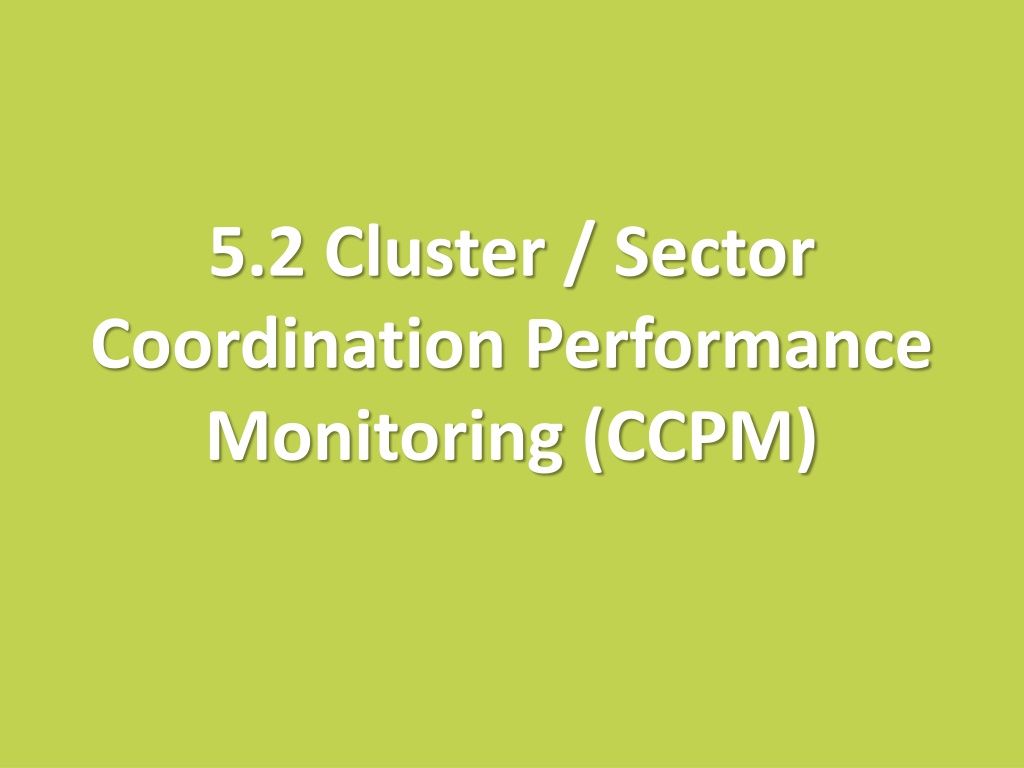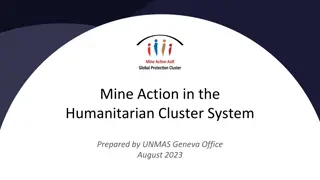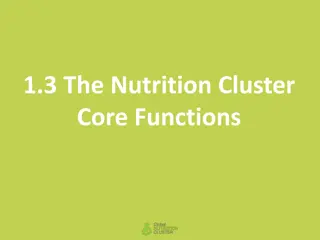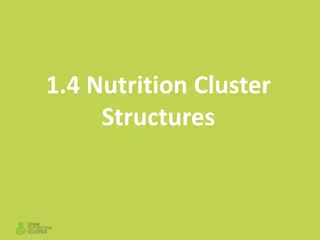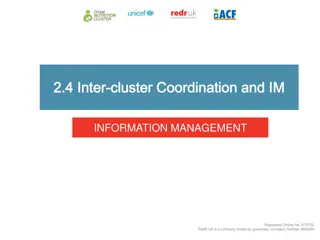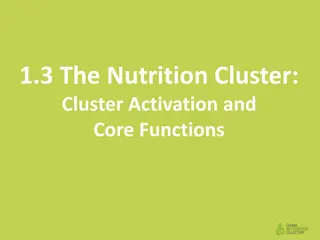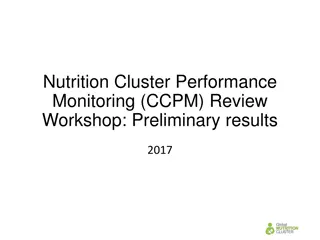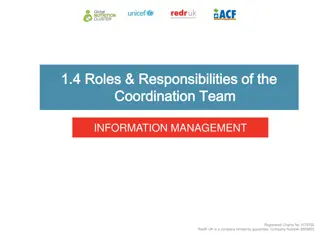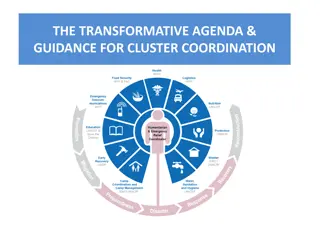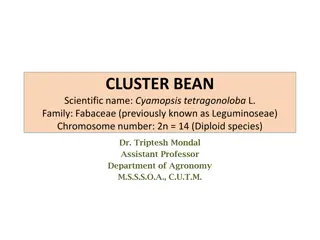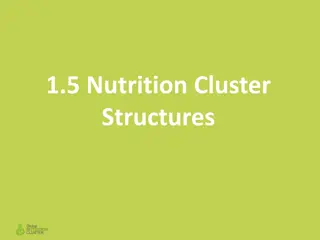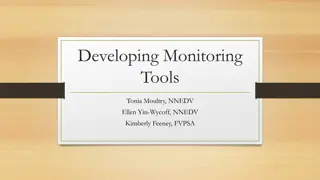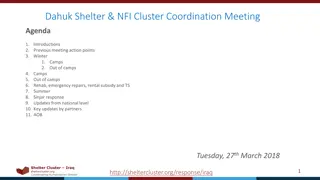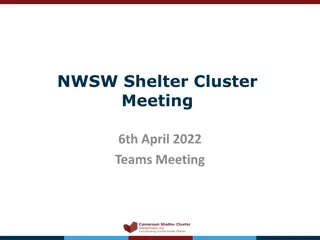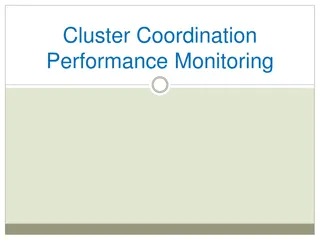Cluster Sector Coordination Performance Monitoring (CCPM)
CCPM involves self-assessment of cluster performance against core functions, excluding monitoring response and evaluating individual partners. It guides when to implement CCPM, the steps involved, and provides examples of Nutrition Clusters completing CCPM. Challenges and successes in supporting service delivery, informing strategic decision-making, and improving overall cluster performance are highlighted.
Download Presentation

Please find below an Image/Link to download the presentation.
The content on the website is provided AS IS for your information and personal use only. It may not be sold, licensed, or shared on other websites without obtaining consent from the author.If you encounter any issues during the download, it is possible that the publisher has removed the file from their server.
You are allowed to download the files provided on this website for personal or commercial use, subject to the condition that they are used lawfully. All files are the property of their respective owners.
The content on the website is provided AS IS for your information and personal use only. It may not be sold, licensed, or shared on other websites without obtaining consent from the author.
E N D
Presentation Transcript
5.2 Cluster / Sector Coordination Performance Monitoring (CCPM)
CCPM Self-assessment of cluster performance against the 6 +1 core cluster functions: 1. Support service delivery 2. Inform the HC/HCT's strategic decision-making 3. Strategy development 4. Monitor and evaluate performance 5. Capacity building in preparedness and contingency planning. 6. Advocacy + Accountability to Affected People
The CCPM does not Monitor response (service delivery). Evaluate individual partners or coordinators. Evaluate if/when clusters should be deactivated, merged etc. (review of the cluster architecture). Exclude usage of other tools with the same purpose.
When to implement the CCPM? In protracted crises: Annually, but clusters decide when to implement it In new emergencies: 3 - 6 months after the onset and once every year thereafter. If several core functions have been registered as weak.
What are the steps for CCPM? STEPS 3. Analysis Action Planning 1. Planning 2.Survey 4. Monitoring OUTPUTS Decision on implementation Preliminary Report Final Report & Action Plan Quarterly Reports to HCT
Nutrition Clusters that have completed CCPM in 2016-2017 South Sudan Somalia Chad Niger Yemen Mali Congo, D.R Ethiopia Bangladesh Sudan Syria C.A.R.
1: Supporting service delivery Overall rating: Good Challenges Information flow between MoH and Nutrition Cluster, national and sub-national level and from Cluster team to partners is weak Cluster approach and core function not well understood by some partners Poor attendance of mtgs by gov and tech staff in field based agencies What is working well In general, partners happy with how service delivery is going Reg mtgs are held Partners list updated regularly Websites developed IM reporting tools available and used Capacity mapping completed Systems to avoid duplications in place
2: Informing strategic decision making of HC/HCT Overall rating: Borderline Unsatisfactory Borderline Unsatisfactory Challenges Prioritization of activities not grounded in strong analysis Gap analysis and prioritization of needs jointly with partners and other clusters is weak Analysis of some cross cutting issues (HIV/AIDS and disability) weak What is working well ..(to partly address this core area) Some needs assessments done Some cross cutting issues analysed (gender, age)
3: Planning and strategy development Overall rating: wide range good to unsatisfactory What is working well . Overall good application and adherence to existing standards and guidelines Strategic plan developed Challenges Need to clarify funding requirements, prioritization and cluster contributions to humanitarian funding considerations No deactivation or phase-out strategy Limited strategic planning at sub-national level Limited sub-national consultation on response plan
4: Implementation and Monitoring Overall rating: wide range good to satisfactory Achievements Systems for regular partner reports are in place (with different level of satisfaction) Some information regularly shared Country bulletins produced Challenges Insufficient reporting back to partners on progress Field monitoring is infrequent Unclear mechanisms for sharing reports with WFP, UNICEF and the Cluster- leads to duplication and gaps Quality of partner reports Timeliness of report submission Limited consideration of partner reports in cluster reporting, publication of cluster bulletins and monitoring Lessons learned not documented and used for programming
5: Build capacity for contingency/preparedness Overall rating: satisfactory Achievements Partners felt involved in planning and risk assessments Challenges Limited partner involvement in risk assessment and analysis Contingency planning scenarios done by OCHA with no consultation of cluster No national contingency plan for nutrition Preparedness plans exist but are outdated
6: Advocacy Overall rating: wide range good to weak Challenges Issues requiring advocacy are not discussed comprehensively within the cluster or proactively taken forward when identified Unclear if advocacy issues get raised to HCT, limited feedback Advocacy has not been adequately addressed by the cluster What is working well . Some satisfied with advocacy discussions and results Advocacy around milk code received unified support
7: Accountability to affected people Overall rating: satisfactory Achievements Partners felt involved in planning and risk assessments Challenges Limited partner involvement in risk assessment and analysis Contingency planning scenarios done by OCHA with no consultation of cluster No national contingency plan for nutrition Preparedness plans exist but are outdated
